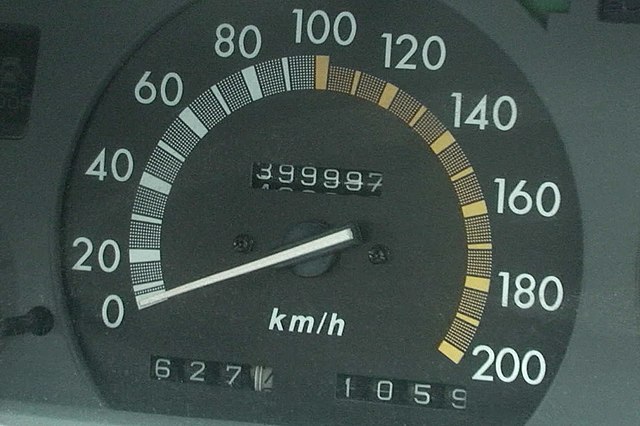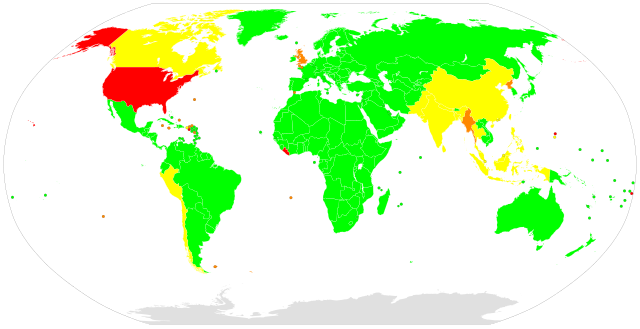公制化
計量單位轉換至公制體系的過程 来自维基百科,自由的百科全书
公制化(英語:metrication)是計量單位轉換為公制的過程[2]。在全世界範圍內,各國由各種地方和傳統計量制度各自獨立地向公制轉變已有很長的歷程;1790年代發端於法國,並在隨後的兩個世紀中廣泛傳播,但公制並未在所有國家和領域得到完全採用。



概述
截至2017年,有7個國家未致力於完成公制化全面轉型的進程[3]:美國及其聯繫邦密克羅尼西亞聯邦、馬紹爾群島和帕勞,官方使用美國的習慣單位(美制單位);利比里亞官方使用美制單位[4];緬甸官方使用緬甸計量單位。然而,據報道,緬甸和利比里亞基本上使用公制,即使沒有官方立法支持。[5]
在英國,公制是多數受監管的計重交易,或以計量目的使用的官方計量單位制度,但一些英制單位仍然是主要的官方計量單位。例如,英里、碼和英尺仍然是道路標誌的官方單位,而且英制單位使用廣泛。[6][7] 此外,英制品脫(Imperial pint)也仍然是可回收瓶裝牛奶以及英國酒吧里生啤酒和蘋果酒的許可單位。 英制單位也可合法地與公制單位一起使用於食品包裝和散裝貨物標價;在用於描述產品時英制單位可單獨使用,但不可作為計量出售的單位。例如:電視屏幕和服裝尺碼往往只以英寸為單位,但除非附有公制單位價格,否則以每英寸標示一塊材料的價格不合法。
利比里亞政府現在確定以使用公制為目標推進[8],且緬甸政府表示,該國將以在2019年前完成為目標推進公制化。[9][10]緬甸和利比里亞實質上都是公制國家,以公制單位進行國際貿易。公制化倡導者對兩個國家的訪問顯示,他們在國內使用公制單位處理許多事務,例外如緬甸使用英制加侖的舊汽油泵。這些國家和其他國家通過國際貿易和標準化在一定程度上採納了公制度量,例如,塞拉利昂在2011年5月轉向以升出售燃料。[11][12]美國在1866年強制商業和法律訴訟接受公制,但不得取代其習慣單位。[13]1897年英國亦效仿,直到1995年才強制大多數用途必須使用公制單位。
1971年,美國國家標準局(National Bureau of Standards)完成了一項為期三年的研究,研究了全球公制使用不斷增加對美國的影響。這項研究最後向國會提交了一份題為《公制美國——順勢而為》(A Metric America - A Decision Whose Time Has Come)的報告。自此之後,美國的公制使用增加了,主要是在製造業和教育領域。1974年8月21日頒佈的第93-380號公共法律規定,美國的政策是鼓勵教育機構和機構,作為常規教育方案的一部分使學生做好準備,以輕鬆和便利地使用公制度量制度。1975年12月23日,時任總統傑拉爾德·福特簽署了公共法94-168,《1975年公制轉換法案》(Metric Conversion Act)。 該法案宣佈了一項協調美國境內逐漸增加的公制使用的國家政策。法案設立了一個美國公制委員會,其職能從1982年10月1日起轉移到商務部公制辦公室,以協調向公制的自願轉換。[14]
大多數國家在一段並用新舊度量衡的過渡時期後正式採用了公制制度。一些國家如圭亞那已經正式採用了公制,但在實施時卻遇到了一些麻煩。[15]安提瓜和巴布達,也是「官方」使用公制,正在向公制計量系統的全面實施邁進,但較預期的要慢。該國政府已經宣佈,他們計劃在2015年第一季度之前將他們的國家轉為使用公制。[16]聖盧西亞等其他加勒比地區國家是官方使用公制,但仍處於全面轉換的過程中。[17]
歐洲聯盟試圖利用《計量單位指令》(Units of Measure Directive)建立共同的計量單位體系,並為歐洲單一市場提供便利。在整個1990年代,歐洲聯盟委員會幫助成員國加快完成其公制轉換進程。其中包括英國,該國的法律在部分或所有情況授權或允許使用許多英制度量單位,如道路標誌上距離所用的英里和碼,以英里每小時標示的限速,啤酒的品脫,以及衣服的英寸。[18][19]英國獲得了對道路標識中的英里和碼,和(與愛爾蘭相同的)在酒吧出售的一品脫(英制)生啤酒的永久豁免(參見英國的公制化)。[20]2007年,歐洲聯盟委員會還宣佈(為了安撫英國公眾輿論和促進與美國的貿易),它將放棄要求包裝商品僅使用公制標籤,並允許公制-英制雙重標識無限期地繼續下去。
在20世紀下半葉或21世紀的第一個十年裏,其他使用英制單位的國家完成了官方的公制化。最近完成這一進程的是愛爾蘭共和國,該國於1970年代開始進行公制化改造,並於2005年初完成。[21]
英制/美制體系對於國際經濟和貿易的影響力正在下降,在兩個計量系統之間進行換算可能因誤差帶來意想不到的危險,以國際客戶為主的英制/美制製造企業多數使用公制以維持競爭力。[22]2007年1月,美國太空總署決定與其他空間機構保持一致,在今後所有的月球任務中使用公制單位。[23]
美國[24][25]、英國[26][27][28]和加拿大[29]國內有積極反對公制化的意見,特別是更新的計量單位法律將使歷史計量體系遭到淘汰的情況下。其他國家,比如法國[30]和日本[31],曾經有大眾的強烈反對聲音,但現在已經完全接受了公制化。
在公制體系之前
秦始皇曾在領土內大力推行書同文、車同軌,廢止各諸侯國貨幣而改用統一秦半兩。公元前211年頒佈的詔書把商鞅時期的衡器作為全國標準,立法確定度量衡器可接受的誤差;並明確6尺為步,240步為畝。但後者只通行於舊秦,東方許多地區的一畝仍為100步。[32]依據秦權(砝碼)銘文推算,當時的一斤為250克。秦孝公十八年(前344年)頒發的標準量器商鞅方升,在底部加刻前211年詔書後沿用為秦統一後的標準器;現代經實測研究得出其容積為202.15立方厘米,結合容器上的銘文「爰積十六尊(寸)五分尊(寸)壹為升」(一升為161/5立方寸),1立方寸=12.478立方厘米,進而得秦統一後與商鞅時1尺=23.2厘米。度量衡在使用中的磨損會引致偏差,故秦明令規定須每年對其進行檢驗和校正。[33]統一度量衡和貨幣便利了經濟發展和貿易往來,促進了中國歷史上首個大一統中央集權國家的發展。[34]
羅馬帝國曾使用pes(「尺」)作為度量。此單位被分為12個uniciae(「寸」)。單位libra(「磅」)則是在羅馬時代之後很長一段時間內對歐洲的重量和貨幣單位有着廣泛的影響,如磅(pound)和英鎊(pound sterling,其符號£即來源於libra的花體字母L[35])。 隨着時間的推移,單位變化很大。[36]查理曼是幾位發起改革的統治者之一,計劃在他們統治的帝國內標準化計量單位和貨幣,但是並沒有真正的總體突破。[37][38][39]
在中世紀的歐洲,關於度量衡的當地法律是由同業公會逐城制定的。例如,厄爾(ell,或elle)是歐洲常用的長度單位,但其長度從德國部分地區的40.2厘米到荷蘭的70厘米和蘇格蘭愛丁堡的94.5厘米不等。1838年瑞士的一項調查顯示,foot(尺)有37種不同的區域變體,厄爾則有68種;干穀粒有83種不同計量單位,液體有70種,禽畜「胴體重量」則有63種。[40]當艾薩克•牛頓(Isaac Newton)在1687年撰寫《自然哲學的數學原理》時,他引用了「巴黎尺」(Parisan feet)作為測量單位,使讀者就可以理解書中涉及的尺寸。至於制定地方城際或國家計量標準的努力,例子有1641年的蘇格蘭法律和1824年的英國標準英制制度(imperial system)——後者仍在英國普遍使用。曾幾何時,封建中國已經成功地在全國範圍內標準化了單位,但到了1936年,官方調查發現了尺的53種數值,從200毫米到1250毫米不等; 32個版本的升,數值在500毫升和8升之間;36種不同的斤,從300克到2500克不等。[41] 據估計,僅在18世紀的法國就有25萬種不同的長度和重量單位。法國大革命之後革命黨人決定廢除所有地方計量單位,他們建立的新計量體系就是國際單位體系的前身[42]。
對單一國際計量體系的渴望來自日益增長的國際貿易以及對貨物應用共同標準的需要。對於一家公司而言,購買在另一個國家生產的產品時,他們需要確保收到的貨物與描述相符。中世紀的單位厄爾之所以被廢棄,部分原因是它的數值無法標準化。國際單位制(SI)的一個主要優勢就是它是國際性的,隨着其日益成為國際通行標準,對各國施加的遵守國際單位制的壓力也越來越大。然而,它也簡化了測量的教學,因為所有的國際單位制(SI)單位都是基於少數基本單位(特別是米、千克和秒囊括了大部分的日常測量場景),使用十進制前綴來涵蓋所有量級。這與前公制(pre-metric)單位形成了鮮明對比,後者的名稱大多不直接相關(例如英寸、英尺、碼、英里),而且它們之間的比例不一致,必須直接記憶(例如12、3、1760)。由於國際單位制(SI)表達式中的值總是小數(即沒有普通分數),以及SI不使用混合單位(如「X英尺Y英寸」),測量值容易相加或相乘。此外,科學測量和計算大大簡化,因為電學、力學等領域的單位是SI系統的一部分,因此都以一致的方式相互關聯(例如1 J=1 kg·m2·s-2=1 V·A·s)。計量標準化對工業革命和一般技術發展作出了重大貢獻[43][44][45][37]。國際單位制不是國際標準化的唯一例子;除了企業之間成立的私有標準化組織,若干強大的國際標準化組織存在於多個行業,如國際標準化組織(ISO)、國際電工委員會(IEC)及國際電信聯盟(ITU)。[45]
公制系統的先行者
十進制數是公制系統的一個重要組成部分,同時系統只有一個基本單位和以10為基底創建的倍數,而前面的數字保持不變。這令計算得到簡化。雖然印度人曾用十進制數字進行數學計算,但是直到1585年才由西蒙·斯蒂文(Simon Stevin)在他的小冊子De Thiende(古荷蘭語中意為「第十」)中首先提倡日常使用小數。 他還宣稱,將十進制數用於貨幣和計量只是時間問題。他對十進制小數的表示方法很笨拙,但隨着小數點的引入,這一點得到克服,這一般歸功於巴塞洛繆·皮提斯卡斯(Bartholomaeus Pitiscus),在他的三角表(1595年)中使用了這種表示法。[46]
約翰·威爾金斯在他1668年發表的《關於真實性格和哲學語言的論文》(Essay towards a Real Character and a Philosophical Language)中,提出一個與今天的公制系統非常相似的計量系統。他建議保留秒作為時間的基本單位,並建議每秒經過起始位置一次的鐘擺移動的長度(即周期為兩秒)應作為長度的基本單位。這一長度——他提議的名稱是「標準」(standard)——將是994毫米。他的基本質量單位——他提議稱之為「百」(hundred)——是一個立方「標準」體積的蒸餾雨水的質量。他所提議的基本計量單位的十進制倍數和子單位的名稱是當時使用的計量單位的名稱。[47][48]
1670年,加布里埃爾·穆頓(Gabriel Mouton)公佈了一項建議,其實質上與威爾金斯的建議相似,只是他的基本長度單位是地理緯度的1/1000弧分(約為1.852米)。他提議把這個單位叫做「virga」。他沒有為每個長度單位使用不同的名稱,而是提出了一系列有前綴的名稱,這種做法與國際單位制類似。[46]
1790年,托馬斯·傑弗遜向美國國會提交了一份報告,他在報告中提議採用十進制硬幣、重量和度量體系。他建議將基本單位長度稱為「尺」(foot),並認為這個單位應該是周期為1秒鐘擺擺動距離的3/10或1/3——也就是威爾金斯一個世紀前提出的「標準」(standard)的3/10或1/3。此單位相當於11.755英寸(29.8厘米)或13.06英寸(33.1厘米)。與威爾金斯一樣,他提出的基準計量單位的倍數和子單位的名稱是當時計量單位的名稱。[49]在這個時代,人們對大地測量學的極大興趣,以及發展起來的計量系統思想,影響了美國大陸被測量和分割的方式。蘇格蘭歷史作家安德羅·林克萊特(Andro Linklater)的《測量美國》中,探討了傑弗遜對新計量系統的完整願景,及其如何接近取代鏈和傳統的英畝但最終卻未如此。[50]
晚清時期度政混亂,受西方列強影響,在海關貿易和實業製造中的度量衡長短不一、中西混用,不論是民間學者抑或朝廷都深感困擾,「各地自為風氣,參差錯雜,不可究詰」。清廷於1908年(光緒三十四年)嘗試實施度政改革,頒佈《度量權衡畫一制度圖說總表推行章程》(《畫一章程》)。而在此前的1905年,曾就讀於福建馬尾船政學堂的葉在揚著成了嚴復為之作序的《度量衡新議》,對中西度量衡進行了比較和討論,提出了一套新的度量衡方案及器具。葉在揚在書中首先指出中國傳統的「黃鐘壘黍說」並不精確,也指出法制(公制)採用的子午線長度為基準,雖然是長久之法,「幾成列邦同度之議」,但弊端在於地球自轉會導致漸漸變形,因此提議使用赤道作為基本長度單位的基準,導出一套獨立於中國傳統和法制(公制)的度量衡單位和度量衡器。葉在揚使用三角法推得赤道周長為131,277,672營造尺,以此為基數,設定為129,600,000「擬定尺」,1米=3.23670擬定尺。擬定度(長度)共有里、引、丈、尺、寸、分、厘,7個單位均為十進制。該書還系統闡述了量器和衡器的計算和設計。但在當時的環境下,再推行一套新的度量衡體系,無疑會再添混亂,故《畫一章程》對《度量衡新議》的改革方案持否定態度,但在權衡和量器圖示多有參照。[51]
採用公制度量衡制度
在19世紀荷蘭、德國和意大利的統一進程中,公制度量衡制度被證明是一種方便的政治妥協。1814年,葡萄牙成為法蘭西帝國以外第一個正式採用公制的國家。西班牙在1858年發現效仿法國的做法是有益的,在十年之內,拉丁美洲也採用了公制。在英國和美國,公制化受到了相當大的阻力;唯英國於1965年宣佈了公制化計劃,英聯邦也隨之效仿。

1795年,法國引入公制,逐個地區推行,巴黎是第一個實施地區;但按照現代標準,這一過渡期管理不善。雖然分發了數以千計的小冊子,負責監督這一過程的計量局卻低估了所涉及的工作量。僅巴黎一個城市就需要50萬支米柱(米原器),然而在米成為唯一的法定計量單位一個月後,他們只有25000支的存量。[7]:269這一點,加上其他過分的革命措施和高文盲率,使公制不受歡迎。儘管1801年9月公製成為陸上貿易可用的唯一計量單位體制,許多人依然使用舊單位工作後再轉換結果至公制,反抗這一變化。[30]
拿破崙本人嘲笑公制,但作為一個能幹的管理者,承認公製作為計量系統健全基礎的價值,並根據1812年2月12日帝國法令(décret impérial du 12 février 1812 ),引進了一種新的計量系統——用於小型零售企業的「習慣度量衡」(mesures usuelles)——所有政府、法律和類似工作領域仍然必須使用公制,公制繼續在各級教育中教授。[52]古代使用的許多單位的名稱被重新引進,但被重新定義為公制單位。 因此,法尋(法語:toise)的定義是2米長,6法尺(法語:pied)為一法尋,12法寸(法語:pouce)為一法尺,12個法分(法語:ligne)組成一法寸。同樣,法磅(里弗爾,法語:livre)也被定義為500克,每里弗爾由16盎司組成,每個盎司等於8格羅斯,一法肘(aune)為120厘米[53]。
根據《1837年7月4日法》(La loi du 4 juillet 1837),路易-菲利普一世,通過重申1795年和1799年衡量法,從1840年5月1日開始停用舊有習慣之度量衡。[54][55] 然而,許多計量單位,如里弗(半千克) ,仍然在日常中使用多年[55][56],殘餘影響直到今天。

在法國大革命爆發時,現代德國和奧地利的大部分國土是神聖羅馬帝國的一部分,後者變成了一個由王國、公國、自由城市、教區和其他封地組成的鬆散聯邦,每個封地都有自己的度量衡系統——儘管多數情況下這些系統是從一千年前由查理曼建立的加洛林王朝時代的體制鬆散地衍生出來的。
在拿破崙時代,德意志的一些邦國採取行動,改革他們的計量體系,使用原型米和千克作為新單位的基礎。例如,巴登在1810年重新定義了杆(德語:Ruthe為3.0米,並將杆的子單位定義為1杆=10尺(德語:Fuß)=100寸(德語:Zoll)=1,000線(德語:Linie)=10,000點(德語:Punkt),而磅(德語:Pfund)被定義為500克,分為30盎司(德語:Loth),每盎司16.67克。[57] [58]巴伐利亞在其1811年的改革中,將巴伐利亞磅(德語:Pfund)從561.288克精確地削減到560克,相當於32盎司(德語:Loth) 組成,每盎司等於17.5克,[59]而普魯士磅(德語:Pfund)保持在467.711克。[60]
維也納會議之後,德意志各邦國之間進行了一定程度的商業合作,成果是德意志關稅同盟(德語:Zollverein)。然而,在1856年巴伐利亞率先制定《德國商法典》之前,貿易壁壘仍然很多。作為法規的一部分,關稅同盟引入了Zollpfund(海關磅),其定義為500克整,可分為30「lot」。[61]這個單位用於邦國間貨物運輸,但並不全部適用於所有國家的內部使用。
雖然在1866年的普奧戰爭之後,關稅同盟崩潰了,但在1872年新成立的德意志帝國和1875年的奧地利,公制體系成為了官方的計量體系。[62][63]1877年以後,海關磅在德國不再合法。[64]

1797年拿破崙於意大利北部建立,定都米蘭的奇薩爾皮尼共和國,首先採用了基於「奇薩爾皮尼腕尺」(意大利語:bracio cisalpino)的改良公制系統,該單位定義為半米。[65]1802年,奇薩爾皮尼共和國改稱意大利共和國,以拿破崙為國家元首。次年,奇薩爾皮尼計量體系被公制體系所取代。[65]
1806年,意大利共和國被意大利王國取代,拿破崙成為其皇帝。至1812年,整個意大利從羅馬向北都在拿破崙的控制之下,無論是作為法蘭西的一部分或作為意大利王國的一部分,確保了公制在整個地區內的使用。
在維也納會議之後,意大利各邦國恢復了它們原來的計量體系;但在1845年,薩丁尼亞王國通過了立法,在五年內引入了公制。到1860年,意大利大部分地區統一在薩丁尼亞國王維托里奧·埃馬努埃萊二世的統治之下,且依據1861年7月28日第132號法律,令公製成為整個王國的官方計量制度。1870年12月31日前,許多轉換表(意大利語:Tavole di ragguaglio)展示在商店裏。[65]
荷蘭先前使用公制,後於1812年起作為法蘭西第一帝國的一部分使用「習慣度量衡」(mesures usuelles)。根據1817年3月27日皇家法令(Koningklijk besluit van den 27 Maart 1817),新成立的荷蘭王國放棄了習慣度量衡系統,採用「荷蘭」公制系統(荷蘭語:Nederlands metrisch stelsel),當中公制單位以當時使用的計量單位命名。 例子包括被定義為100克的盎司(荷蘭語:ons)。[66]
1814年8月,葡萄牙正式採用公制,但其單位名稱跟隨葡萄牙傳統單位。在這個系統中,基本單位是: 1手(葡萄牙語:mão-travessa)=1分米,10手=1碼(葡萄牙語:vara)=1米;1加納得(葡萄牙語:canada)=1升;1磅(葡萄牙語:libra)=1千克。
直到1700年波旁王朝崛起前,西班牙的每個地區都保留了自己的計量系統。新的波旁王朝試圖將控制權集中,並隨之推行計量制度。關於保留卡斯蒂利亞時代單位,或者為了協調而採用法國體系是否可取曾經有過爭論。[67]雖然西班牙協助了皮埃爾·梅尚(法語:Pierre Méchain)進行子午線調查,但政府懼怕法國革命運動,並以加強卡斯蒂利亞時代單位體系的方式抗衡法國大革命運動。然而到了1849年,事實證明舊體系很難維持,當年公製成為西班牙的法定計量制度。[67]

1852年,西班牙皇家科學院敦促政府批准繪製一幅大比例的西班牙地圖。次年,卡洛斯·伊瓦涅斯·伊瓦涅斯· 德伊韋羅(Carlos Ibáñez e Ibáñez de Ibero)被任命承擔這項任務。所有的科學和技術材料都必須創造出來。卡洛斯·伊瓦涅斯·伊瓦涅斯·德伊韋羅和薩韋德拉(Saavedra)前往巴黎,監督布倫納(Brunner)生產他們設計的一種測量儀器,後來他們將這種儀器與讓-夏爾·德博爾達(Jean-Charles de Borda)的雙突阿斯N°1進行了比較,後者是法國所有大地測量基準的主要參考,長度為3.8980732米。
1865年,西班牙的三角測量網絡與葡萄牙和法國的聯繫在一起。1866年,在納沙泰爾的大地測量協會(Association of Geodesy)會議上,伊瓦涅斯宣佈西班牙將合作重新測量巴黎子午線弧。1879年,伊瓦涅斯和法國軍官弗朗索瓦·佩里耶(François Perrier)完成了西班牙大地測量網和法屬阿爾及利亞之間的連接,從而完成了從昔德蘭群島延伸到撒哈拉的巴黎子午線弧的測量。
1867年,俄羅斯、西班牙和葡萄牙加入了歐洲大地測量協會(德語:Europäische Gradmessung),該組織後演變為國際大地測量協會。同年,在柏林舉行的第二屆歐洲弧度測量大會上,討論了國際標準長度單位的問題,以便將不同國家的測量結果結合起來,確定地球的大小和形狀。根據約翰·雅各布·拜耳(Johann Jacob Baeyer,普魯士軍官),阿道夫·希爾施(Adolphe Hirsch,德國天文學家)和卡洛斯·伊瓦涅斯·伊瓦涅斯·德伊韋羅的提議,會議建議採用米制並設立一個國際米制委員會。
1869年11月,法國政府發出加入該委員會的邀請。西班牙接受,卡洛斯·伊瓦涅斯·伊瓦涅斯·德伊韋羅參加了1870年國際米制委員會 (頁面存檔備份,存於互聯網檔案館)第一次會議籌備研究委員會的工作。 1872年,他成為國際米制委員會常設委員會主席。1874年,伊瓦涅斯被選為歐洲弧度測量常設委員會主席。他還主持了1875年在巴黎舉行的歐洲弧測量大會,當時該協會決定為基地的測量建立一個國際大地測量標準。[68]他代表西班牙參加了1875年在巴黎召開的米制公約會議。這位西班牙大地測量工作者當選為國際度量衡委員會的第一任主席。他的活動成果是在1889年舉行的國際度量衡大會第一次會議期間向所有米制公約締約國分發了一個鉑銥合金米原器。這些米原器直至1960年都作為米的定義基準。
1824年的《度量衡法案》(Weights and Measures Act)將一個標準的「帝國」(Imperial)度量衡體系加諸於大英帝國。[69]這一法案的效果是使現有的英國計量單位標準化,而不是使它們與公制統一。
在接下來的80年裏,一些議會特別委員會建議採用公制,每次都有更高程度的緊迫性,但議會卻猶豫不決。1862年的一份特別委員會報告建議強制公制化,但設有一個「中間寬容階段」;1864年議會的反應是將公制單位合法化,但僅限於「合同和交易」。[70]聯合王國最初拒絕《米制公約》,但在1883年最終簽署。與此同時,英國科學家和技術人員走在了公制化運動的前沿——正是不列顛科學協會將厘米-克-秒制(CGS system of units)作為一個連貫的系統進行推廣,也正是英國公司莊信萬豐(Johnson Matthey)在1889年被國際度量衡大會(CGPM)接受為國際米和千克原器的鑄造者。[71]:109[72]
1895年,另一個議會特別委員會建議在兩年的寬容期之後強制採用公制。1897年的《度量衡法案》使公制貿易單位合法化,但沒有強制執行。一項規定強制使用公制,目的是使英國工業基地能夠擊退新生的德國基地的挑戰的法案,1904年在上議院獲得通過。但是英國下議院沒有在下一次大選前通過這項法案。1907年,由於蘭開夏郡棉花產業的反對,一項類似的法案以150票對118票在英國下議院被否決。
1965年,英國啟動了官方的公制化計劃,截止2012年還沒有完成。英國的公制化計劃標誌着英聯邦其他地方公制化計劃的開始;但印度在1959年已啟動其計劃,比聯合王國早6年。南非(當時不是英聯邦成員)在1967年設立了一個公制化諮詢委員會(Metrication Advisory Board),新西蘭在1969年設立了它的公制諮詢委員會(Metric Advisory Board),澳洲在1970年通過了公制轉換法案(Metric Conversion Act),加拿大在1971年任命了一個公制化委員會(Metrication Commission)。澳洲、新西蘭和南非在十年內基本完成了公制化,而印度和加拿大的公制化尚未完成。此外,lakh(十萬盧比)和crore(一千萬盧比)在印度仍然廣泛使用;而在加拿大,由於與美國的密切貿易關係,平方英尺仍然廣泛用於商業和住宅廣告,部分用於建築工程,而鐵路繼續以英里表示軌道裏程和時速限制,因其也在美國範圍內運營業務。大多數其他英聯邦國家在20世紀70年代改用公制。[73]
1805年,瑞士大地測量師費迪南德·魯道夫·哈斯勒(Ferdinand Rudolph Hassler)將法國米和千克原器的複製品帶到了美國。[74]1830年,國會決定在美國建立統一的長度和重量標準。[75]哈斯勒受命制定新的標準,並提議採用公制。[75]國會選擇了1758年的英國議會標準和1824年的英國特洛伊磅作為長度和重量的標準。[75]然而,美國海岸測量的主要基線是1834年在紐約州法爾島用4根2米長的鐵棒測量的,這些鐵棒則是於英國按照哈斯勒的規格製造的,並於1815年運回美國。[76][77]美國國家大地測量中的所有距離都是以米計算的。[78]1866年,美國國會通過了一項法案,規定在美國使用公制合法。該法案性質為許可,而非強制執行;它用慣用的美制單位而非國際米和千克原器來定義公制。[79][80]:10–13至1893年,以美制單位作為參考標準變得不可靠。此外,美國作為米制公約的簽署國,擁有本國的米和公斤標準原器,這些原器參照世界其他地方所用的校準。這引出了門登霍爾法令(Mendenhall Order),該法令參照國家公制原器重新定義了美制單位,但使用了1866年法案的換算係數。[80]:16–20 1896年,一項將令公制變為強制性使用的法案遞交至美國國會。在國會委員會面前作證的29人中,23人贊成該法案,6人反對。6位反對者中有4位代表製造業利益,另外2位代表美國稅務局。反對者引述的理據是轉換的成本和不便。該法案未獲通過。其後的法案也遭遇了類似的命運。[63]
轉換進度

完成
接近完成
部分完成
少有採用
公制系統於1799年正式引入法國。在19世紀中,公制系統獲得了幾乎所有歐洲國家的採用:葡萄牙(1814年)[81];荷蘭、比利時和盧森堡(1820年);瑞士(1835年);西班牙(1850年代);意大利(1861);羅馬尼亞(1864);德國(1870年,法定為1872年1月1日)[82];和奧匈帝國(1876,法律上於1871年)[63]。泰國在1923年前未曾正式採用,但其皇家測量部門(Royal Thai Survey Department)早至1896年即將公制用於地籍測量。[83]丹麥和冰島於1907年採用公制。
例外
相關事件和事故
參見
參考來源
外部連結
Wikiwand - on
Seamless Wikipedia browsing. On steroids.
